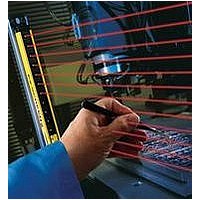IM-T-11A BANNER ENGINEERING, IM-T-11A Datasheet - Page 4

IM-T-11A
Manufacturer Part Number
IM-T-11A
Description
Interfacing Module
Manufacturer
BANNER ENGINEERING
Datasheet
1.IM-T-11A.pdf
(12 pages)
Specifications of IM-T-11A
Supply Voltage Max
24VDC
Control Output Type
2NO/1NC
It is not possible to give exact wiring instructions for an Interface Module which can be used
with many different primary safety devices and can interface to a multitude of machine control
configurations. The following guidelines are general in nature.
The Interface Module has no delay function. Its output relay contacts open within 20 milliseconds
Figure 4. Generalized hookup to a 2-channel primary safety device with two hard-contact safety
4
after a safety input opens. This classifies the Safety Module as functional stop "Category 0", as
defined by ANSI NFPA 79 and IEC/EN 60204-1.
The inputs can be connected to (that meet the requirements for primary safety device above):
• A +24V dc solid-state (PNP) outputs in single-channel or dual-channel hookup configuration, or
• A +24V/0V dc source that is switched by hard/relay contacts in single-channel or dual-channel
The dual-channel hookup configuration (Figures 4 through 8) allows the primary safety device
to detect certain failures and faults, such as short circuits, that could result in a loss of the safety
function. Two-channel control should be used whenever unsafe failure of the control wires cannot
be eliminated. This circuit (Figure 4) can meet ISO 13849-1 Category 2, 3, or 4 requirements,
depending on the safety rating and the installation of the primary safety device.
The outputs of the primary safety device must, at minimum, comply with the requirements
described on page 3. These outputs must be monitored for failure by the primary safety device.
In addition, a single output failure cannot prevent normal stopping action, and a successive cycle
cannot be initiated until the failure has been corrected.
hookup configuration.
P/N 62822 rev. C
outputs (FSD1 and FSD2) and two monitoring inputs
+24V dc
Machine
Control
Electrical Installation
Feedback (optional)
S3
S4
13
23
33
Primary
Safety
Device
Safety Output
Safety Output
K2
K2
IM-T-9A
EDM1
EDM2
K1
K1
S1
S2
Y1
Y2
Y3
Y4
14
24
34
MPCE2
MPCE
2
MPCE1
MPCE
1
– Interface Modules
– Interface Modules
0V dc
Banner Engineering Corp.
Banner Engineering Corp.
www.bannerengineering.com • Tel: 763.544.3164
www.bannerengineering.com • Tel: 763.544.3164
Always disconnect all power from
the Interface Module, the primary
safety device, and all power from
the machine being controlled before
making any connections or replacing
any component. Electrical installation and
wiring must be made by qualified personnel
and must comply with the NEC (National
Electrical Code), ANSI NFPA79 or IEC
60204-1, and all applicable local standards
and codes.
The level of safety circuit integrity can
be greatly impacted by the design and
installation of the safety devices and the
means of interfacing of those devices. A
risk assessment must be performed to
determine the appropriate safety circuit
integrity level or safety category as
described by ISO 13849-1 (EN 954-1) to
ensure that the expected risk reduction
is achieved and that all relevant
regulations and standards are complied
with.
When FSD1 switches +24V dc and FSD2
switches 0V dc (Figures 4 and 5), a short
circuit between the wires leading to S1, S2,
S3 and S4 is detected immediately and K1
and K2 de-energize. However, a short
circuit can result in a high current through
the FSD1 and FSD2 contacts, so the
current coming from the 24V dc supply
connected to FSD1 and FSD2 must be
fused or limited to 6 amps max. Otherwise,
damage to the primary safety device may
result.
WARNING . . .
CAUTION . . .
CAUTION . . .
•
•
Minneapolis, MN U.S.A.
Minneapolis, MN U.S.A.
Shock Hazard
Safety Categories






















